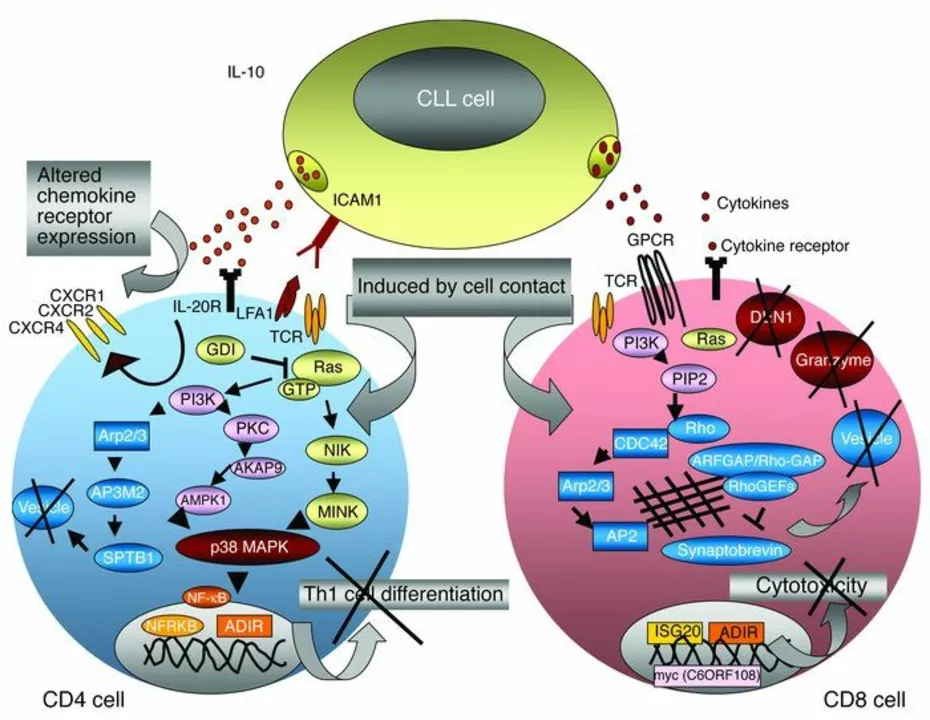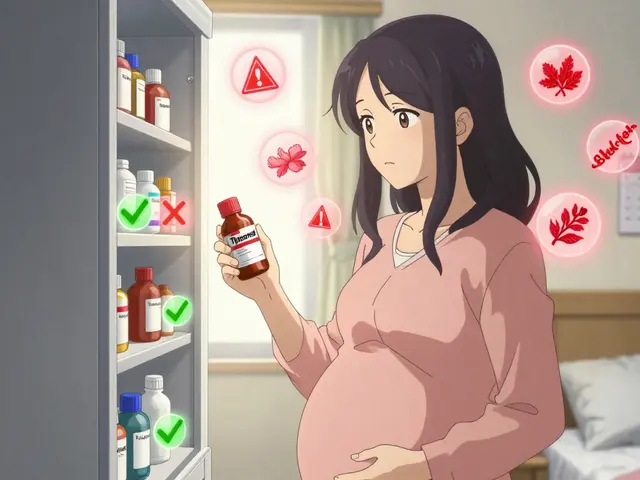Understanding Chronic Lymphocytic Leukemia
As a parent, hearing the words "chronic lymphocytic leukemia" (CLL) can be incredibly scary. This rare but serious condition affects the white blood cells in the body, specifically the lymphocytes, which play a crucial role in the immune system. In CLL, abnormal lymphocytes accumulate in the blood, bone marrow, and other tissues, disrupting the proper function of healthy cells and increasing the risk of infections.
Although CLL is more common in adults, it can also affect children. In this article, we will explore the diagnosis, symptoms, treatment options, and support resources available to families facing this challenging situation.
Identifying the Symptoms of CLL in Children
Early detection is key in managing and treating CLL. Children may exhibit various symptoms, some of which may be subtle or easily mistaken for other illnesses. Common signs of CLL in children include:
- Fatigue and weakness
- Unexplained weight loss
- Frequent infections and slow healing
- Swollen lymph nodes in the neck, armpits, or groin
- Enlarged liver or spleen
- Anemia or low platelet count
If you notice any of these symptoms in your child, it is essential to consult with a healthcare professional for proper evaluation and diagnosis.
Diagnosing CLL in Children
Diagnosing CLL involves several tests and examinations, including a physical examination, blood tests, and imaging studies. The most definitive test for CLL is a bone marrow biopsy, where a sample of the bone marrow is removed and examined under a microscope to determine the presence of abnormal lymphocytes.
Once CLL is confirmed, additional tests may be conducted to determine the stage of the disease, which can help guide treatment decisions.
Treatment Options for CLL in Children
Treatment for CLL in children typically involves a combination of chemotherapy, immunotherapy, targeted therapy, and stem cell transplant. The specific treatment plan will depend on the stage of the disease, the child's overall health, and other factors. Some of the possible treatment options include:
- Chemotherapy: The use of drugs to kill cancer cells or stop them from growing.
- Immunotherapy: Treatment that helps the immune system fight cancer more effectively.
- Targeted therapy: Drugs that specifically target cancer cells without damaging healthy cells.
- Stem cell transplant: A procedure that replaces damaged or destroyed bone marrow with healthy bone marrow stem cells.
Throughout the treatment process, the child's healthcare team will closely monitor their progress and adjust the treatment plan as needed.
Managing Side Effects and Complications
Children undergoing treatment for CLL may experience various side effects and complications, such as nausea, vomiting, fatigue, hair loss, and an increased risk of infection. It is essential to work closely with the healthcare team to manage these side effects and ensure your child's comfort and well-being.
In addition to medical interventions, providing emotional support and maintaining a sense of normalcy can help children cope with the challenges of their condition.
The Importance of a Multidisciplinary Team
Successfully managing CLL in children requires the coordination of a multidisciplinary team of healthcare professionals, including pediatric oncologists, hematologists, nurses, and social workers. This team will collaborate to develop a comprehensive treatment plan tailored to your child's specific needs and provide ongoing support throughout the treatment process.
As a parent, it is crucial to maintain open communication with the healthcare team and stay informed about your child's progress and any changes to the treatment plan.
Seeking Support and Resources for Families
Dealing with a CLL diagnosis can be overwhelming for both children and their families. It is essential to seek support from friends, family, and professional resources. Many organizations offer information, emotional support, and financial assistance to families affected by pediatric cancer, including the Leukemia & Lymphoma Society, the American Cancer Society, and the National Cancer Institute.
Connecting with other families facing similar challenges can also provide valuable insight, encouragement, and hope.
Understanding the Long-Term Outlook for Children with CLL
The long-term outlook for children with CLL depends on various factors, such as the stage of the disease, the child's overall health, and the effectiveness of treatment. Advances in medical research and treatment have led to improved survival rates for many pediatric cancers, including CLL.
It is essential to maintain regular follow-up care and monitoring to ensure the ongoing health and well-being of your child, even after successful treatment.
Final Thoughts: Facing CLL with Hope and Resilience
Chronic lymphocytic leukemia in children is undoubtedly a challenging and difficult diagnosis. However, with early detection, advanced treatment options, and a strong support system, many children can successfully manage and overcome this rare but serious condition. As a parent, it is essential to remain hopeful, resilient, and proactive in your child's care, and to seek the support and resources needed to navigate this journey.


19 Comments
Jonathan S
June 2, 2023Parents who encounter a diagnosis of CLL in their child often feel a rush of fear, outrage, and a deep sense of moral duty to protect the vulnerable.
Society owes these families not only cutting‑edge medical care but also unwavering ethical support, because neglect is tantamount to betrayal.
The medical establishment must be held accountable for ensuring that every child, regardless of socioeconomic status, gains access to the latest targeted therapies.
Equity in healthcare is not a vague ideal; it is a concrete obligation that we should measure in real dollars and appointment slots.
Families should demand transparent communication from oncologists, refusing vague euphemisms that mask the real stakes.
Transparency empowers patients, and without it we are left to navigate a labyrinth of insurance jargon and bureaucratic delay.
The psychosocial side effects, such as chronic anxiety and isolation, deserve as much attention as hair loss or nausea, because emotional well‑being is a medical outcome too.
Support groups function as lifelines, providing not only empathy but also practical tips on managing school attendance and medication schedules.
Parents must also be vigilant about infection control, as the compromised immune system of a child with CLL can turn a common cold into a life‑threatening event.
Vaccination strategies, when appropriate, should be discussed early, and any hesitation can cost precious time.
Moreover, researchers are pushing forward with CAR‑T cell trials that show promise, and families should stay informed about clinical trial eligibility.
The ethical imperative extends to the community: raising awareness reduces stigma and encourages donations that fund pediatric oncology research.
Every share on social media, every fundraiser, every conversation at the kitchen table adds a brick to the bridge toward cure.
Do not let the rarity of pediatric CLL lull you into complacency; rarity should sharpen, not dull, our collective resolve.
Remember, the fight is not just medical-it is moral, social, and deeply human, and we must march forward together. 😊🙂
Charles Markley
June 2, 2023The pathophysiological underpinnings of pediatric CLL demand a lexicon replete with oncogenic signaling cascades, epigenetic dysregulation, and microenvironmental immunosuppression, rendering layperson discourse woefully inadequate.
L Taylor
June 2, 2023Life is a series of battles the smallest warrior within us rises when the odds seem impossible it’s a cosmic reminder that hope is a choice
Matt Thomas
June 2, 2023Honestly, the article definitely overlooked the fact that CLL in kids is not just a ‘rare event’; it’s a glaring example of systemic oversight.
The data presented is *inaccurate* in several sections-teh authors need to proofread.
Nancy Chen
June 2, 2023What if the pharma giants are silently engineering the scarcity of pediatric CLL treatments to keep the market monopoly intact? The hidden agenda behind ‘clinical trials’ often serves profit over pure science.
Jon Shematek
June 2, 2023Hey everyone, stay strong! 💪 There are amazing therapies out there and a whole community rooting for you-keep the faith and push forward!
Beverly Pace
June 2, 2023It is our ethical obligation to amplify these families’ voices, not let them fade into the background.
RALPH O'NEIL
June 2, 2023I’ve noticed a pattern where multidisciplinary teams improve outcomes significantly; coordination seems key.
Mark Wellman
June 2, 2023Honestly this whole post feels like a recycled press release, same generic fluff slapped together with no real depth, and I’m tired of reading the same tired spiel over and over again.
Amy Morris
June 2, 2023My heart aches for every child forced to endure endless hospital corridors; the courage they show is nothing short of heroic, and we must honor their struggle.
Francesca Roberts
June 2, 2023Sure, because reading a 5‑minute article will magically cure CLL-*sigh* you might want to consult an actual oncologist.
Becky Jarboe
June 2, 2023Curiosity drives progress; diving into recent immunotherapy data could unveil newer protocols that reduce toxicity while maintaining efficacy.
Carl Boel
June 2, 2023Our nation must champion pediatric oncology research; funding domestic labs is a patriotic duty that saves American kids.
Shuvam Roy
June 3, 2023Let us unite in purpose and ensure each child receives the best possible care; together we can make a measurable difference.
Jane Grimm
June 3, 2023While the exposition is commendably thorough, its verbose nature obfuscates critical actionable insights, thereby diminishing its practical utility.
Nora Russell
June 3, 2023A superficial summary fails to interrogate the socioeconomic determinants that stratify access to cutting‑edge therapies, exposing a glaring analytical void.
Craig Stephenson
June 3, 2023I think we all agree that sharing resources and experiences will benefit families; let’s create a wiki of tips and links.
Tyler Dean
June 3, 2023The hidden cabal of elite labs manipulates trial data to conceal cure possibilities.
Susan Rose
June 3, 2023In many cultures extended families rally around sick kids, providing meals and emotional support that hospitals can’t replace.